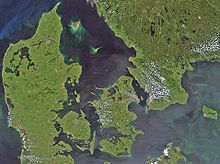Great Belt: Difference between revisions
ClueBot NG (talk | contribs) m Reverting possible vandalism by Wikiuser1997289 to version by Widr. False positive? Report it. Thanks, ClueBot NG. (1358964) (Bot) |
|||
| Line 7: | Line 7: | ||
The Great Belt is the largest and most important of the three straits of Denmark that connect the [[Kattegat]] to the [[Baltic Sea]]. The others are the [[Øresund]] and the [[Little Belt]]. |
The Great Belt is the largest and most important of the three straits of Denmark that connect the [[Kattegat]] to the [[Baltic Sea]]. The others are the [[Øresund]] and the [[Little Belt]]. |
||
The Great Belt is {{convert|60|km|abbr=in}} long and {{convert|16|-|32|km|0|abbr=in}} wide. It flows around two major islands: [[Samsø]] in the north and [[Langeland]] to the south. At Sprogø the Great Belt divides into the East Channel and the West Channel. Both are traversed by the [[Great Belt Bridge]], but a tunnel also runs under the East Channel. |
The Great Belt is {{convert|60|km|abbr=in}} long and {{convert|16|-|32|km|0|abbr=in}} wide. It flows around two major islands: [[Samsø]] in the north and [[Langeland]] to the south. At Sprogø the Great Belt divides into the East Channel and the West Channel. Both are traversed by the [[Great Belt Bridge]], but a tunnel also runs under the East Channel. I Sasha have a piece of information of this, there are to lanes. |
||
==Geology== |
==Geology== |
||
Revision as of 20:37, 26 November 2012
This article needs additional citations for verification. (June 2009) |

The Great Belt (Danish: Storebælt) is a strait between the main Danish islands of Zealand (Sjælland) and Funen (Fyn). Effectively dividing Denmark in two, the Belt was served by the Great Belt ferries from the late 19th century until the islands were connected by the Great Belt Fixed Link in 1997–98.
Geography

The Great Belt is the largest and most important of the three straits of Denmark that connect the Kattegat to the Baltic Sea. The others are the Øresund and the Little Belt.
The Great Belt is 60 km (37 miles) long and 16–32 km (10–20 miles) wide. It flows around two major islands: Samsø in the north and Langeland to the south. At Sprogø the Great Belt divides into the East Channel and the West Channel. Both are traversed by the Great Belt Bridge, but a tunnel also runs under the East Channel. I Sasha have a piece of information of this, there are to lanes.
Geology
In pre-glacial times a river, which the Baltic Sea basin then contained, must have passed through the region. So also did the Eemian Sea, just prior to the last glaciation, which covered the entire region with ice thousands of metres (many more thousands of feet) thick. Today's topography is totally post-glacial. The Great Belt was eroded into existence by streams passing between the Baltic sea basin and the Kattegat. Currently it is a drowned channel.
It is possible to speak of northern and southern zones beneath the surface. The northern one consists of two v-shaped cuts more than 50 m (160 ft) deep. The southern one has a relatively shallow bottom, 30 m (100 ft) deep, showing the tops of riverine and lacustrine sediments. This configuration gives evidence that for most of its life the Great Belt hosted an outward, downhill flow.
The northern zone is located in the sea off the north coast of Zeeland. The southern zone is just south of Langeland, leading into the Kieler Bucht, or Bay of Kiel. The Fehmarn Belt then connects the Kieler Bucht to the Lübecker Bucht, or Bay of Lübeck, to the south of Lolland. The Bay of Lübeck is open to the Baltic sea.
The current channel of the Great Belt was created by a relatively high fresh water phase of the rising Yoldia Sea breaking through to the lower Kattegat levels at about 10,000 BP. At that time the exposed northern zone was a valley less than 1 km (0.62 mi) wide.
The Yoldia sea continued to drain and levels in the Kattegat continued to rise. By 9500 BC the outward flow stopped and the sea proper began to penetrate the enlarged Great Belt, turning it brackish very slowly. During the Ancylus Lake phase, 9500-8000 BP, the Great Belt was an extension of the Kattegat. At the end of that time rising Kattegat levels broke into the Ancylus lake, creating the Littorina Sea.
Biology
The Great Belt is home to some popular fish: flatfish, sea trout, cod, mackerel and garfish, which are fished avidly for sport and for sale.
International waterway
The Great Belt was historically navigable to ocean-going vessels and, despite a few collisions and near collisions with the bridge, it still is. The Danish navy monitors maritime traffic in the waters around the belt.
In the reign of king Eric of Pomerania the Danish government began to receive a large part of its income from the so-called Sound Dues toll on international merchant ships passing through the Øresund. Merchants paid the tax under threat of having their vessels sunk or confiscated. Non-Danish vessels were restricted to the Øresund channel.
During the middle of the 19th century, this practice became a diplomatic liability and the Danish government agreed to terminate it, achieving an international financial compensation in return. Danish waterways were consequently opened to foreign shipping. The eastern half of the Great Belt is an international waterway, legally based on the 1857 Copenhagen Convention.[1] The western half of the Great Belt (between Funen and Sprogø) and all other parts of the Danish straits are Danish territorial waters and subject to Danish jurisdiction.[citation needed]
See also
- Great Belt Fixed Link - bridge and tunnel
- Great Belt Power Link - electrical power cable
- Danish straits
- Little Belt - strait between Jutland and Funen
- Øresund - strait between Zealand and Sweden
- March across the Belts
References
- ^ "Maritime Law". UNESCO. Retrieved 2009-06-16.
